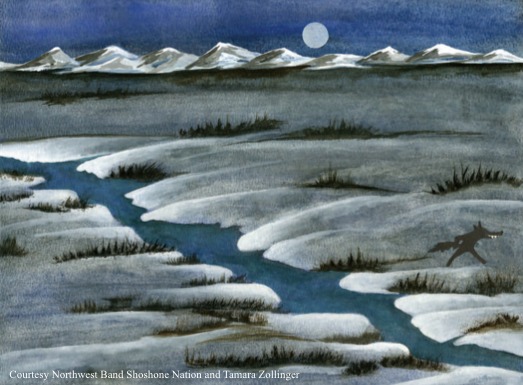Dublin Core
Title
Description
Fur trappers who wintered in northern Utah’s Cache Valley during the early 19th century called it, “the most beautiful valley in the Rocky Mountains.” But winters were rough, with deep, drifting snows, and freezing temperatures anytime from September to June. This harsh weather shaped the lives of local Shoshone peoples and early Mormon settlers, who -- if they wanted to live in Cache Valley -- had to figure out how to transform winter from an obstacle to an opportunity.
Shoshone people tackled this problem by moving strategically around their homelands with the seasons. For centuries, they harvested grasses, seeds, and fish in the summer before hunkering down in winter camps located near hot springs. The springs provided refuge, and food preparations during the previous year helped them meet the challenges of a bitter winter. In present-day southern Idaho, the Shoshone regularly gathered at a winter camp named Mosokotani – meaning “home of the lungs” for the local lava rock that resembles lung tissue. There, tribal members shared advice, told stories, and celebrated the Warm Dance to welcome spring.
The harsh winters of Cache Valley were a shock to the first Mormon settlers, with four inches of snow falling within days of their arrival in September 1856. Their wagons and woodpiles were covered in snow by December and did not thaw until spring. The growing season for crops was short and many trade routes became inaccessible under snowdrifts. But like the Shoshone, they forged ahead and prepared for the cold with year-round planning. Grist-mills harnessed stream flows to provide food for winter and harvesting ice from frozen ponds provided refrigeration for food storage. Women gathered straw during summer to make hats in winter, and weaving became inside work when fields were frozen. Residents used sleighs, skates, and skis to make their way across the icy landscape to homes throughout the valley.
A harsh environmental obstacle, winter in Cache Valley also became an opportunity for creativity and rejuvenation. Storing food, managing water use, and spending time together indoors proved to be key to human survival for both Shoshone and Mormon communities.
Creator
Source
_______________
See Cache Daughters of Utah Pioneers Museum, exhibition file for Obstacle or Opportunity? Winter Shapes Life in Cache Valley curated by Sharon Johnson, 2021; Northwestern Band of Shoshone, Coyote Steals Fire: A Shoshone Tale (Logan, UT: Utah State University Press, 2005); “Mary Ann Weston Maughan Journal,” Historical Diaries, Utah State University Digital Collections; USU Orientation, “The History of the Natural Ice Company,” Youtube, posted July 27, 2016; “Ann Batting Atkinson (1827-1895),” Cache Daughters of Utah Pioneers Museum Collection, Utah State University Digital Collections.

